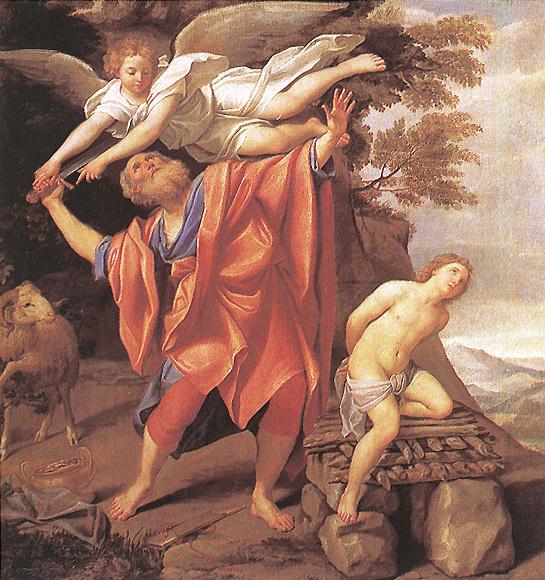The Eucharist as the Fulfillment of God’s Presence in the Tabernacle
As part of my master’s in theology classes, I’ve been studying the Old Testament and salvation history, which is God’s plan for our salvation.
Typology

The Sacrifice of Isaac by Domenichino via Wikimedia Commons
One of the things I loved about Catholicism as a new Catholic was its explanation of the New Testament through the lens of the Old Testament. This is a concept called “typology,” which simply means that many things in the Old Testament are “types” or prefigurements of things in the New. And the New is the complete fulfillment of the Old.
The Catechism of the Catholic Church explains that typology…
“…discerns in God’s works of the Old Covenant prefigurations of what he accomplished in the fullness of time in the person of his incarnate Son.” (CCC, 128)
Another way I like to describe typology is using Jesus as the “key” that unlocks the meaning of the Old Testament. The Old Testament only truly makes sense in light of Jesus. This is how stories like Abraham’s sacrifice of Isaac finally made sense to me: as a prefigurement of God’s ACTUAL sacrificing of His only son.
The use of typology dates back to the early Church Fathers, including to Origen of Alexandria, who was really a master of typology, seeing signs and prefigurements throughout almost all of the Old Testament.
Understanding Jewish History, Culture and Customs to Understand God’s Plan of Salvation
As you study the Old Testament, it’s important to learn about the Jewish culture and customs of the time to see how the things these people began before Jesus are fulfilled in Jesus and even in our own day.
Without this knowledge, you miss key portions of what the Old Testament and God’s plan for salvation are all about.
Author Brant Pitre has done an amazing job of outlining these customs and the Jewish culture in very understandable and fascinating books like “Jesus and the Jewish Roots of the Eucharist” and “Jesus and the Jewish Roots of Mary” (please note these are Amazon affiliate links; I appreciate you using my links to support this endeavor :)). You can also find some of Pitre’s lectures on the topic on Formed.org if your parish subscribes to this awesome service.
The Eucharist Prefigured in the Old Testament
I recently had the pleasure of attending a talk by Father Mike Schmitz live here in Indianapolis where he talked about the Eucharist (the Eucharist is what Catholics consume during communion and what we believe to be the actual body and blood of Jesus Christ, not a symbol).
He explained how in John Chapter 6, Jesus tells us that this is one of the ways He will give himself to us, and by turning away from this teaching, we are not accepting what Jesus wanted for us and Jesus as He fully revealed Himself. He also talked about how the Eucharist is Jesus’ physical presence with us and how He is giving his body to us in this way.
While reflecting on this afterward, I had a lightbulb moment. Just as nearly everything in the Old Testament is prefigurement of something in the New, so God’s presence in the Old Testament likely has a New Testament fulfillment.
In the Old Testament, God “dwelled” or “pitched His tent” among the people in a variety of ways. (Note: This is the same word John uses in John 1:14 when he says the Word, Jesus, “made his dwelling among us”). The ways God dwelled among the people was first in the Ark of the Covenant, then in the Tabernacle and finally in the Temple.
During the Babylonian exile, God’s presence left the Temple never to return in the Old Testament. We’ll come back to this…
God’s Presence and The Eucharist
Protestants who do not believe in the real presence of Jesus in the Eucharist will often say God is always with us anyway. After all, Jesus says…
“Where two or three are gathered together in my name, there am I in the midst of them.” (Matthew 18:20)
And no doubt God IS always with us, as He was always with the Jewish people even when His presence left the temple. But there is a qualitative difference between that spiritual presence and the physical presence of God.
This physical presence manifested itself in the Ark, the tabernacle and the Temple, such that if anyone so much as touched the Ark, they were struck dead. And only the priest could enter the Holy of Holies where God dwelled and even then, only once a year.
While many have found “types” of the Eucharist in things like the manna God provided the Israelites in the desert and the Bread of the Presence, which was also found in the Temple, I think God’s presence dwelling in the Ark, the Tabernacle and the Temple is also an Old Testament prefigurement of the PHYSICAL presence of God in our midst.
First and foremost, Jesus himself is the fulfillment of God’s presence in the Old Testament. God’s presence RETURNS in Mary (who is herself a fulfillment of the Ark of the Covenant, described as the NEW Ark of the Covenant, and which Luke deliberately points to through various words and events to describe her) as Jesus. He literally “made his tent” among us, taking on flesh and walking with us in person.
But Jesus, too, ultimately had to depart from our midst, but He wanted to still remain physically present with us, to “dwell” with us “…until the end of the age” as He promises in Matthew 28:20.
I believe the Eucharist is that physical fulfillment of God’s presence in our time, from the time Jesus ascended into heaven. Not only is He with us spiritually but physically should we go to seek Him out.
To me, this lends further support to Jesus’ real presence in the Eucharist. It simply has to be when you follow the line of logic, considering the Old and New Testament connections, not to mention His emphatic statements declaring as much that turned off many followers in John Chapter 6.
Jesus, fully present to us in the Eucharist, pray for us.



